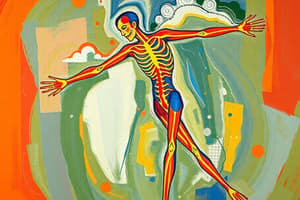Podcast
Questions and Answers
What specific motor deficit would you expect Jerry to exhibit due to his left-side weakness?
What specific motor deficit would you expect Jerry to exhibit due to his left-side weakness?
- Dysarthria
- Ataxia
- Visual field cuts
- Hemiplegia on the right side (correct)
Which motor tract lesion is most likely responsible for Jerry's left-side weakness?
Which motor tract lesion is most likely responsible for Jerry's left-side weakness?
- Medial lemniscus pathway lesion
- Corticospinal tract lesion (correct)
- Vestibulospinal tract lesion
- Spinocerebellar tract lesion
What functional limitation is commonly associated with spasticity following a middle cerebral artery stroke?
What functional limitation is commonly associated with spasticity following a middle cerebral artery stroke?
- Dystonia
- Intention tremors
- Bradykinesia
- Hyperreflexia (correct)
Which area of the brain is primarily affected by a medial motor tract lesion?
Which area of the brain is primarily affected by a medial motor tract lesion?
Which motor function is commonly impaired due to a lateral motor tract lesion?
Which motor function is commonly impaired due to a lateral motor tract lesion?
Which of the following motor tract lesion signs is characterized by hyperactive reflexes?
Which of the following motor tract lesion signs is characterized by hyperactive reflexes?
What is the term used to describe the loss of fractionation of movement seen in motor tract lesions?
What is the term used to describe the loss of fractionation of movement seen in motor tract lesions?
In post-stroke impairments, what is a common indicator of loss of proprioception?
In post-stroke impairments, what is a common indicator of loss of proprioception?
Which motor tract is associated with overactivity in the reticulospinal tract post middle cerebral artery stroke?
Which motor tract is associated with overactivity in the reticulospinal tract post middle cerebral artery stroke?
What functional limitation can result from myoplastic changes post middle cerebral artery stroke?
What functional limitation can result from myoplastic changes post middle cerebral artery stroke?
Which symptom is commonly seen in clients with postural malalignment after a stroke?
Which symptom is commonly seen in clients with postural malalignment after a stroke?
Which group of motor tracts control posture and proximal movements?
Which group of motor tracts control posture and proximal movements?
Which tract controls wrist and finger extensors?
Which tract controls wrist and finger extensors?
What type of movements do fine movement tracts (lateral MTs) control?
What type of movements do fine movement tracts (lateral MTs) control?
Which motor tract originates in the motor cortex and connects directly to the spinal cord?
Which motor tract originates in the motor cortex and connects directly to the spinal cord?
What limitations are typically associated with MCA stroke?
What limitations are typically associated with MCA stroke?
Which tract is involved in postural adjustment and reaching movements?
Which tract is involved in postural adjustment and reaching movements?
What is the primary function of the lateral corticospinal tract?
What is the primary function of the lateral corticospinal tract?
What sensory inputs are necessary for postural control?
What sensory inputs are necessary for postural control?
Which motor tract facilitates neck movement responses to environmental stimuli?
Which motor tract facilitates neck movement responses to environmental stimuli?
What is the function of the nonspecific tracts in motor control?
What is the function of the nonspecific tracts in motor control?
Flashcards are hidden until you start studying
Study Notes
Motor Deficits and Lesions
- Expect left-sided motor deficits, including weakness in the right arm and leg due to contralateral brain involvement.
- Common lesion responsible for left-side weakness is found in the right side of the brain, affecting the corticospinal tract.
- Spasticity following a middle cerebral artery (MCA) stroke often leads to limited range of motion and difficulties with movement initiation.
Affected Brain Areas and Impairments
- A medial motor tract lesion affects the area controlling posture and proximal movements, primarily in the brainstem.
- Lateral motor tract lesions commonly impair fine motor skills, like precision in finger movements.
- Hyperactive reflexes are signs of upper motor neuron lesions, indicating a motor tract lesion.
Proprioception and Movement Control
- Loss of proprioception in post-stroke impairments can manifest as difficulty in spatial awareness and balance.
- Overactivity in the reticulospinal tract is associated with motor dysfunction post MCA stroke.
- Myoplastic changes can lead to muscle stiffness and weakness, restricting movement after an MCA stroke.
Postural Control and Motor Tracts
- Postural malalignment after a stroke often results in the inability to maintain an upright position.
- Tracts controlling posture and proximal movements include the vestibulospinal and reticulospinal tracts.
- The lateral corticospinal tract specifically controls wrist and finger extensors, enabling gripping and precise hand movements.
Movement Types and Control Mechanisms
- Fine movement tracts (lateral motor tracts) are essential for skilled, coordinated tasks, especially in the hands and fingers.
- The cortico-spinal tract, originating from the motor cortex, connects directly to the spinal cord, facilitating voluntary movements.
- Typical limitations following MCA stroke include hemiparesis, speech deficits, and challenges in daily functional tasks.
Motor Functions and Sensory Inputs
- The tract involved in postural adjustment and reaching movements is largely the medial corticospinal tract.
- The primary function of the lateral corticospinal tract is to enable voluntary control over skilled and precise motor activities.
- Sensory inputs necessary for postural control include proprioceptive feedback, visual cues, and vestibular information.
- The nonspecific tracts serve to modulate and enhance the overall motor responses rather than initiate specific movements.
Studying That Suits You
Use AI to generate personalized quizzes and flashcards to suit your learning preferences.




